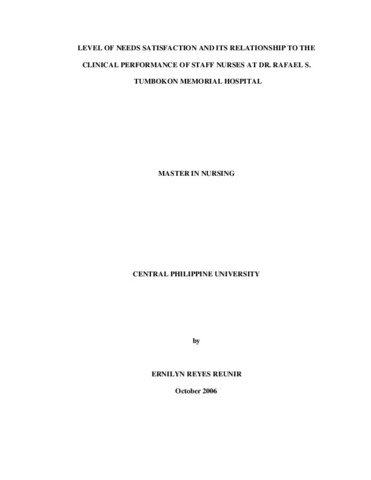Level of needs satisfaction and its relationship to the clinical performance of staff nurses at Dr. Rafael S. Tumbokon Memorial Hospital

Page views
700Petsa
2006May-akda
Tagapayo ng Tesis
Tagapangulo ng Panel ng Depensa
Magbahagi
Metadata
Ipakita ang buong tala ng item
Abstract
The study was conducted to determine the relationship between the needs satisfaction and clinical performance level of staff nurses at Dr. Rafael S. Tumbokon Memorial Hospital (DRSTMH).
Specifically, the study aimed to answer the following specific questions: 1) What is the profile of nurses at Dr. Rafael S. Tumbokon Memorial Hospital in terms of age, position, monthly salary, and length of service; 2) What is the level of needs satisfaction of nurses at Dr. Rafael S. Tumbokon Memorial Hospital in terms of physiologic, safety and security, love and belonging, self-esteem, and self-actualization needs; 3) What is the level of clinical performance of nurses at Dr. Rafael S. Tumbokon Memorial Hospital; 4) Is there a relationship between the nurses’ age, position, monthly salary, and length of service and their needs satisfaction level; 5) Is there a relationship between the nurses’ age, position, monthly salary and length of service and their clinical performance level, and; 6) Is there a relationship between the nurses’ needs satisfaction level and their level of clinical performance.
The respondents were the thirty-six (36) nurses with permanent status of employment at the DRSTMH. A self-administered questionnaire was used as the instrument in gathering data. The questionnaire was prepared based on the objectives of the study. To facilitate data gathering, the respondents were identified through the nurses’ profile which was taken from the list of employees at the Administrative Office of DRSTMH.
The descriptive method of research was used in this study. This research method is concerned with the nature or condition that exist: attitude, beliefs or point of view that are being felt; practices that prevail; methods or processes that are going on; trends that are developing; more gathering of data for it also involves measurement and evaluation.
The data obtained from the questionnaire were organized and tabulated for statistical treatment and to answer the statements of the problem. The results were presented in the tables constructed for the purpose.
The researcher used statistical tools such as frequency counts to account the attribution of a certain variable, percentages to rank the quality of the variables, and mean to obtain a single value which can best describe or represent certain data.
The thirty-six (36) nurse-respondents were both young (39 years old and below) and old (above 39 years old) with Nurse 1 and Nurse 2 positions, where 77.78 percent were receiving a monthly salary of Php 10,000.00 and below and the other 22.22 percent received a salary of above Php 10,000.00. Twenty-two of them has served for 9 years and below while 14 has served for 10 years and above.
The needs satisfaction level of all the respondents was “Satisfied”.
The clinical performance of the respondents was rated “Fair”.
The needs satisfaction level of the respondents was dependent on their length of service, while age, position and monthly salary have nothing to do with the respondents’ needs satisfaction level.
There is no relationship between the respondents’ age, monthly salary, and length of service and their clinical performance. However, a relationship is seen on the position and their clinical performance.
It was found out that the nurses’ needs satisfaction level is highly associated with their clinical performance.
Paglalarawan
Abstract only
Mungkahing Sipi
Reunir, E. R. (2006). Level of needs satisfaction and its relationship to the clinical performance of staff nurses at Dr. Rafael S. Tumbokon Memorial Hospital (Unpublished Master’s special paper). Central Philippine University, Jaro, Iloilo City.
Uri
Special paperMga Paksa
Mga keyword
Kagawaran
School of Graduate StudiesDegree
Master in NursingLokasyon ng Istante
GSL Theses 610.73072 R318
Pisikal na paglalarawan
55 leaves
Collections
- Master in Nursing [37]


